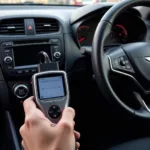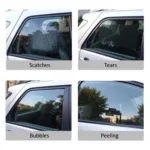Blending paint during a car repair, especially along a ridge or body line, is a crucial skill for achieving a seamless, professional finish. Whether you’re fixing a scratch, dent, or larger area of damage, understanding how to blend paint correctly will prevent that noticeable “patched” look. This guide will walk you through the process, offering expert tips and techniques to help you achieve a flawless blend.
Understanding the Challenges of Blending Paint on a Car Repair Ridge
Blending paint on a car’s ridge presents unique challenges due to the way light interacts with the curved surface. The slightest mismatch in color or texture can be magnified, making the repair more obvious. Factors like the car’s original paint color, the type of paint used for the repair, and the application technique all play a role in the final outcome.
Materials and Preparation for a Seamless Blend
Before you begin, gather the necessary materials: high-quality automotive paint, primer, clear coat, sandpaper (various grits), masking tape, tack cloth, and a spray gun (if spraying). Thoroughly clean the repair area with soap and water, then degrease it with a wax and grease remover. Sand the area with progressively finer grits of sandpaper, feathering the edges of the repair to create a smooth transition. Mask off the surrounding areas to protect them from overspray.
Priming and Base Coat Application Techniques
Apply a thin, even coat of primer to the repaired area, allowing it to dry completely before sanding lightly. Next, apply the base coat, using thin, overlapping coats. Pay close attention to the ridge, ensuring even coverage. Avoid applying too much paint at once, as this can lead to runs and drips.
Blending Techniques for a Flawless Finish
Blending involves gradually fading the new paint into the existing paint. This is achieved by lightly sanding the outer edges of the base coat with a very fine grit sandpaper and then applying a few light coats of paint beyond the repair area, gradually reducing the amount of paint with each pass. This creates a seamless transition between the new and old paint.
Clear Coat Application and Final Finishing
Once the base coat is dry, apply several coats of clear coat, again using thin, overlapping passes. Allow the clear coat to dry completely before wet sanding and polishing to achieve a smooth, glossy finish.
Common Mistakes to Avoid When Blending Paint on a Ridge
Common mistakes include not properly preparing the surface, applying too much paint, not blending far enough, and not using the correct type of paint. These errors can result in a noticeable repair and detract from the overall appearance of the vehicle.
Conclusion: Achieving a Professional Car Repair Paint Blend
Blending paint on a car repair ridge requires patience, attention to detail, and the right techniques. By following the steps outlined in this guide, you can achieve a professional-looking repair that seamlessly blends with the existing paint. Remember to choose high-quality materials and practice your technique to achieve the best possible results.
FAQ
-
What type of paint should I use for blending? Use high-quality automotive paint that matches the car’s original color.
-
How far should I blend the paint? Blend the paint beyond the repair area, gradually fading it into the existing paint.
-
What grit sandpaper should I use for blending? Use a very fine grit sandpaper (e.g., 2000-grit) for blending.
-
How can I avoid runs and drips? Apply thin, overlapping coats of paint.
-
Do I need to use a clear coat? Yes, a clear coat protects the base coat and provides a glossy finish.
-
What if my car has a tri-coat paint system? Tri-coat systems require specialized blending techniques, often best left to professionals.
-
What should I do if I’m not confident in my blending skills? Consider seeking professional help from an experienced auto body repair shop.
Common Car Repair Ridge Blending Scenarios
- Repairing scratches and scuffs along door edges and wheel arches
- Blending paint after repairing minor dents on body lines
- Addressing paint chips and imperfections on the hood and trunk ridges
Related Articles:
- How to Choose the Right Automotive Paint
- DIY Car Painting Tips and Tricks
- Understanding Clear Coat Application and Maintenance
Need expert assistance? Contact us via WhatsApp: +1(641)206-8880, Email: [email protected]. We have a 24/7 customer support team.


